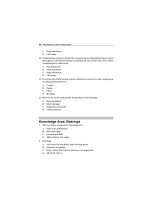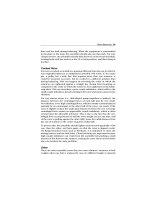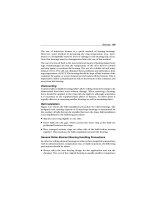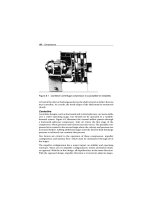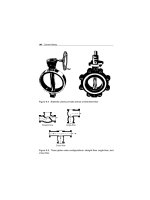Industrial Machinery Repair Part Episode 1 Part 3 ppsx
Bạn đang xem bản rút gọn của tài liệu. Xem và tải ngay bản đầy đủ của tài liệu tại đây (121.1 KB, 25 trang )
34 Maintenance Skills Assessment
C. Drip lubricator.
D. Oil sump.
18 A lubrication system in which the component needing lubrication rotates
through an enclosed housing containing oil and carries the oil to other
components is called a(n):
A. Dip lubricator.
B. Shot lubricator.
C. Drip lubricator.
D. Oil sump.
19 In a force-feed lubrication system, lubricant is moved to the component
needing lubrication by a:
A. Cooler.
B. Pump.
C. Filter.
D. Bearing.
20 What is the most undesirable by-product of oil misting?
A. Bearing failure
B. Shaft damage
C. Explosion potential
D. Oil breakdown
Knowledge Area: Bearings
1 The two basic categories of bearings are:
A. Plain and antifriction.
B. Ball and roller.
C. Journal and ball.
D. Pillow-block and roller.
2 Bearings:
A. Are found in machines with moving parts.
B. Function as guides.
C. Help reduce the friction between moving parts.
D. All of the above.
Maintenance Skills Assessment 35
3 Thrust bearings:
A. Support axial loads on rotating members.
B. Support radial loads on rotating members.
C. Both A and B.
D. None of the above.
4 Antifriction bearings:
A. Contain balls.
B. Contain rollers.
C. Will run hot if they are overlubricated.
D. All of the above.
5 Bearing lubrication systems include:
A. Lubrication by hand.
B. Central grease systems.
C. Pressure-feed oil systems.
D. All of the above.
6 Plain bearings operate by:
A. Separating the races with balls or rollers.
B. Using an air gap.
C. Hydraulics.
D. Running on a film of lubricant.
7 Antifriction bearings operate by:
A. Separating the races with balls or rollers.
B. Using an air gap.
C. Hydraulics.
D. Running on a film of lubricant.
8 Roller bearings are used over ball bearings for which of the following
situations?
A. High-speed applications
B. High-load applications
C. Wet environments
D. Mobile equipment engines
9 Bearing clearance can be described as:
A. The space between the rolling elements and the races.
B. The allowed difference between the shaft size and the bearing inner
race.
C. The allowed differences between bearing inner and outer race.
D. None of the above.
36 Maintenance Skills Assessment
10 Shaft tolerance can be defined as:
A. The allowed difference between the shaft size and the bearing inner
race.
B. The force applied during installation.
C. The space between the rolling elements and the races.
D. None of the above.
11 The preferred method for installing an antifriction bearing is:
A. With a sledge hammer.
B. To sand down the shaft until the bearing slides on.
C. With a bearing heater.
D. Both B and C.
12 When tightening the lock-nut on a spherical roller bearing, the preferred
tool is:
A. A spanner wrench.
B. A bearing heater.
C. A hammer and punch.
D. None of the above.
13 The bearing best suited for both radial and thrust loads is a
bearing.
A. tapered-sleeve
B. linear-motion
C. needle
D. tapered-roller
14 A bearing lubricated with oil is capable of
speeds than the same
bearing lubricated with grease.
A. lower
B. higher
C. the same
D. different
15 As you tighten the nut on a spherical-roller bearing, the space between
the race and the rolling element:
A. Increases.
B. Decreases.
C. Remains the same.
D. Develops cracks.
Maintenance Skills Assessment 37
16 On a metric bearing with the number 7307, the ID of the bearing is:
A. 35 mm.
B. 7 mm.
C. .035".
D. .007".
17 To convert the metric shaft size of a bearing to inches, you multiply the
millimeters by:
A. 5.
B. 39.
C. .03937.
D. .05.
18 A failed bearing that has a cracked inner race probably failed
because:
A. the shaft was too large.
B. of a lack of lubricant.
C. the operator failed to do the proper inspection.
D. of overlubrication.
19 An antifriction bearing can run hot because:
A. of overlubrication.
B. it is about to fail.
C. of excessive load.
D. all of the above.
20 A 20% increase in bearing load, can result in a
% decrease in
bearing life.
A. 20
B. 100
C. 50
D. 10
Knowledge Area: Chain Drives
1 What is the maximum elongation that a roller chain can tolerate before
it should be replaced?
A. 10%
B. 3 inches
38 Maintenance Skills Assessment
C. 3%
D.
3
16
inch per ft. of chain
2 What causes roller fatigue?
A. Lack of lubrication
B. Contamination
C. Improper chain tension
D. All of the above
3 What problems will chain misalignment cause?
A. Side plate wear
B. Sprocket wear
C. Pin wear
D. Chain break
4 What are the two most important factors in the life of a silent chain
drive?
A. Lubrication and alignment
B. Lubrication and tension
C. Tension and alignment
D. All of the above
5 What type of machine guard limits the operator’s access to the danger
zone?
A. Safety chain
B. E-stop
C. A barrier guard
D. None of the above
6 What type of machine guard prevents access to the danger zone
altogether?
A. An enclosure guard
B. Safety chain
C. Barrier guard
D. None of the above
7 Name the two main groups of mechanical couplings:
A. Rigid and flexible.
B. Chain and gear.
C. Grid and Lovejoy.
D. Spring and centrifugal.
Maintenance Skills Assessment 39
8 Large fans are typically powered in what way?
A. Motor and belts
B. Motor and chain drive
C. Motor direct drive
D. Motor, gearbox, and belts
9 Which type of conductivity cells are usually equipped with a safety chain
to prevent the cell from blowing out?
A. Immersions
B. Insertion
C. Flow
D. Screw-in
10 Chain-linked fences should be topped with:
A. Three strands of electrically energized wire.
B. Barbed wire.
C. A skirt of the same material that kicks back 45 degrees and extends
18 inches.
D. None of the above.
11 What are the two links that make up a standard roller chain?
A. Roller, rigid
B. Roller, pin
C. Master, half
D. Offset, half
12 On a roller chain with a designation of 35, what do the 3 and the
5 designate?
A. 3 is the size in inches; 5 is the duty
B. 3 is the duty; 5 is the size in thousandths of an inch
C. 3 is the size in eighths of an inch; 5 means a rollerless chain
D. 3 is the size; 5 means heavy duty
13 What is the maximum elongation that a roller chain can tolerate before
it should be replaced?
A. 10%
B. 3 inches
C. 3%
D.
3
16
inch per ft. of chain
40 Maintenance Skills Assessment
14 What causes roller fatigue?
A. Lack of lubrication
B. Contamination
C. Improper chain tension
D. All of the above
15 What problems will chain misalignment cause?
A. Side plate wear
B. Pin wear
C. Chain break
D. All of the above
16 What are the two most important factors in the life of a silent chain drive?
A. Lubrication and alignment
B. Lubrication and tension
C. Tension and alignment
D. Tension and speed
17 Name the two main groups of mechanical couplings.
A. Rigid and flexible
B. Chain and gear
C. Grid and Lovejoy
D. Spring and centrifugal
18 What type of machine guard limits the operator’s access to the danger
zone?
A. Safety chain
B. E-stop
C. A barrier guard
D. None of the above
19 What type of machine guard prevents access to the danger zone
altogether?
A. An enclosure guard
B. Safety chain
C. Barrier guard
D. None of the above
20 What is the tension or slack a roller chain is recommended to have?
A. 10% slack between centers
B.
1
2
inch slack
C. 5% slack between centers
D. 2% slack between centers
Maintenance Skills Assessment 41
Knowledge Area: Belt Drives
1 Of the following, what are the four main types of belt drives?
A. V-belt; flat belt; timing belt; ribbed belt
B. Straight belt; V-belt; gear belt; ribbed belt
C. Rubber; vitron; buna-n; teflon
D. Round belt; dual face belt; V-belt; multibelt
2 Identify routine maintenance performed on flat belts.
A. Tensioning
B. Cleaning
C. Dressing
D. Both A and B
3 Which of the following is an acceptable V-belt installation process?
A. Reduce center-to-center distance of the pulleys.
B. Use a pry bar to slide the belt over the pulleys.
C. Tension the belt until your hand bounces off the belt.
D. All of the above.
4 Which of the following contribute to rapid belt wear?
A. Oil, dirt, heat, and alignment
B. Water, dirt, sunlight, and tension
C. Guarding, shielding, reflection, and direction
D. Sunlight, dry-rot, mold, and water
5 Why do timing or gear belts not require high tension?
A. They do not require tensioning.
B. The material they are made of reduces slippage.
C. They provide slip-proof engagement.
D. There is not load fluctuation.
6 Different speeds are required for various materials when cutting with a
band saw. How is saw speed adjusted?
A. Set the speed indicator to the desired rpm and start the machine.
B. Adjust the belt tensioner and start the machine.
C. Start the machine and adjust the speed indicator.
D. Dial in the correct job selector and start the machine.
7 Belt drives are designed to transmit power between a drive unit and a:
A. Conveyor belt.
B. Motor.
42 Maintenance Skills Assessment
C. Driven unit.
D. Roller.
8 A drive belt with the designation “XL” would indicate which of the
following types?
A. Cogged, fractional horsepower
B. Conventional V-belt
C. Narrow V-belt
D. Positive drive belt
9 A drive belt with the designation “C” would indicate which of the
following types?
A. Power band belt
B. Conventional V-belt
C. Narrow V-belt
D. Fractional horsepower
10 A drive belt with the designation “V” would indicate which of the
following types?
A. Positive drive belt
B. Conventional V-belt
C. Narrow V-belt
D. Fractional horsepower
11 A “C” belt with a nominal length of 60 inches is
4
10
" long. What
identification should be marked on the belt?
A. C410
B. C60/4
C. C64
D. C56
12 When replacing one of a set of belts, the mechanic should:
A. Replace the worn belt only.
B. Replace the worn belt and the belt closest to the drive motor.
C. Replace all of the belts.
D. Replace the worn belt and the belt farthest from the drive motor.
13 What criteria should be used to determine if a belt needs to be replaced?
A. The belt protrudes above the top of the sheave no more than
1
16
".
B. The belt is flush with the top of the sheave groove.
C. The belt is recessed more than
1
16
" into the groove sheave.
D. The belt is recessed more than
1
8
" into the groove sheave.
Maintenance Skills Assessment 43
14 The length of belt is determined by its:
A. Pitch line.
B. V-line.
C. Standard line.
D. None of the above.
15 When “timing” is a critical consideration with a belt, which of the
following is typically used?
A. Joined belt
B. V-belt
C. Cogged belt
D. Positive drive belt
16 Regarding sheave grove angle, which of the following statements is
correct?
A. Smaller diameter sheaves have less groove angle than larger diame-
ter grooves.
B. Larger diameter sheaves have less groove angle than smaller diame-
ter sheaves.
C. Groove angles are not affected by sheave diameter.
D. Can be compensated for by adjusting belt tension.
17 Which of the following conditions can cause excessive belt wear?
A. Dirty operating conditions
B. Improper sheave alignment
C. Improper tensioning
D. All of the above
Knowledge Area: Hydraulics
1 What function does a reservoir serve in a hydraulic system?
A. Stores surplus of oil
B. Cools the oil
C. Cleans the oil
D. A, B, and C
2 Why is there a baffle in a hydraulic reservoir?
A. To prevent baffling
B. To assist in cleaning and cooling of the oil
C. To keep the oil level the same
D. To prevent overpressurization of the reservoir
44 Maintenance Skills Assessment
3 What should the fluid pass through before it reaches the pump?
A. Prepump precipitator
B. Metal diffuser
C. Heat exchanger
D. Strainer
4 What are the three basic types of positive displacement pumps?
A. Centrifugal, gear, piston
B. Air pump, piston, centrifugal
C. Piston, gear, vane
5 What function does a relief valve provide in a hydraulic system?
A. Protects the system from overpressurization
B. Dumps oil back to the tank
C. Cools the oil
D. A and B
6 What function does an actuator serve in a hydraulic system?
A. To hold pressure in a system
B. To assist the pump in flow
C. To allow work to be performed
D. A and B
7 What are the four basic types of center conditions (envelopes) in the
directional control valves of a hydraulic system?
A. Open, close, tandem, return
B. Bidirectional, unidirectional, terminal, return
C. Tandem, float, closed, open
D. The center position is the same in all valves
8 What function do flow control valves serve in the hydraulic system?
A. Control pressure to a point in the system.
B. Control the speed of an actuator.
C. Reduce the speed of a pump.
D. Eliminate return in one direction.
9 What are the two basic types of flow control arrangements in a hydraulic
system?
A. Meter in, meter out
B. Flow control, flow decontrol
Maintenance Skills Assessment 45
C. Meter in, direct flow
D. Control, directional control
10 What are the two basic types of actuators in a hydraulic system?
A. Bladder, piston
B. Cylinder, motor
C. Double cylinder, single cylinder
D. Pump, actuator
11 Which of the following are means by which a directional control valve
may be actuated?
A. Manual
B. Solenoid operated
C. Pilot pressure
D. All of the above
12 The variable volume pump used most often in high-pressure systems is
what type of pump?
A. Vane
B. Piston
C. Gear
D. Centrifugal
13 Basic hydraulics theory tells us that pressure:
A. On a confined liquid is transmitted undiminished in every direction.
B. Acts with equal force on equal areas.
C. Acts at right angles only on the container side walls.
D. Acts with equal force on reduced areas.
14 Hydraulics is the science of transmitting force or motion through a
medium of a:
A. Confined liquid.
B. Nonconfined liquid.
C. A and B.
D. None of the above.
15 Component parts connected to each other by fluid lines in the hydraulic
system form a:
A. Closed center system.
B. Bypass.
C. Circuit.
D. Motor.
46 Maintenance Skills Assessment
16 A needle valve in a hydraulic line provides a:
A. Flow control orifice.
B. Pressure control orifice.
C. Relief valve.
D. Master valve.
Knowledge Area: Couplings
1 A major advantage of flexible couplings is that they:
A. Compensate for thermal expansion.
B. Provide greater torsional transfer than rigid couplings.
C. Require only minimal motor alignment.
D. Operate at higher rpm than rigid couplings.
2 Name the two main groups of mechanical couplings:
A. Rigid and flexible.
B. Chain and gear.
C. Grid and Lovejoy.
D. Spring and centrifugal.
3 Which of the following couplings requires lubrication?
A. Slider
B. Steelflex
C. Torus rubber
D. Sure-Flex rubber
4 Measurements taken at the top and bottom of a coupling are taken to
adjust:
A. Vertical alignment.
B. Horizontal alignment.
C. Angular alignment.
D. Parallel alignment.
5 When performing coupling alignment, the first activity that must be
conducted is to:
A. Check runout.
B. Verify angular misalignment.
C. Verify parallel misalignment.
D. Check coupling spacing.
Maintenance Skills Assessment 47
6 Which of the following measuring tools is most useful for the straight-
edge method of coupling alignment?
A. Dial indicator
B. Dial caliper
C. Taper gauge
D. Vernier dial indicator
7 Cooling tower fan shafts are supported by:
A. Hubs.
B. Bearings.
C. Couplings.
D. Back plate.
8 How are cooling tower fan blades attached?
A. Brazed
B. Welded
C. With U-bolts
D. Coupling
9 When a high-speed gear mesh coupling is removed from a compressor,
the coupling is typically match marked. What is the purpose of this?
A. Ensures that it can be reassembled correctly.
B. Ensures that it is disassembled correctly.
C. Ensures that one coupling half is aligned to mesh.
10 Some centrifugal compressors use a high-speed gear-type coupling. How
is this type of gear attached to the compressor shaft?
A. Bolted
B. Welded
C. Keyed
D. Interference fit
11 With high-speed gear couplings, gear teeth showing a large polished
area indicate which of the following?
A. Proper gear mesh
B. Unit operation beyond recommended capacity
C. Gear wear
D. Galling
48 Maintenance Skills Assessment
12 High-speed gear-type coupling for motor-to-centrifugal compressor con-
nections are typically lubricated by:
A. Grease.
B. Forced air.
C. Process fluid.
D. Oil.
13 Hose connections that are frequently made and “broken” would use
which of the following types of couplings?
A. Flange
B. Push-on
C. Quick-connect
D. Reusable
14 KAMAG generators may use any number of drivers. Which of the
following coupling types are NOT recommended to tie the two together?
A. Flexible
B. Gear
C. Solid
D. Both B and C
15 A common return signal wire shared by two or more signal wires is
known as:
A. Impedance coupling.
B. Magnetic coupling.
C. Electrostatic coupling.
D. Dielectric coupling.
16 Which of the following comes in two pieces?
A. Coupling
B. Union
C. Bushing
D. Reducer
17 What type of fitting is used to connect tubing through a control panel
or junction box?
A. Coupling
B. Bulkhead
C. Compression
D. Cross
Maintenance Skills Assessment 49
Benchmark your mechanical knowledge: Go to Appendix A for the correct
answers and grade as follows:
Safety: total right/20 =
Lubrication: total right/20 =
Bearings: total right/20 =
Chain Drives: total right/20 =
Belt Drives: total right/17 =
Hydraulics: total right/16 =
Couplings: total right/17 =
Final Score: total of the scores/130 =
69% or below = Needs extensive mechanical training
70% –79% = Needs moderate mechanical training
80% –95% = Needs to review mechanical subject areas
95% –100% = Needs no training
4 Safety First, Safety Always
Introduction
As an industrial mechanic, you should always make safety your primary
concern in the workplace. No job should be performed that would endanger
your life or the lives of others. Always remember, “Safety first, safety last,
safety always.”
Each year in the United States more people are injured or killed in accidents
at home, at work, school, at play, or while traveling than were injured or
killed in either the Korean or Vietnam wars.
Efforts to lessen or to eliminate the conditions that cause accidents are
known as safety measures. Safety is a growing concern around the world,
and safety skills are being taken more seriously today than ever before.
People have come to realize that safety can be learned. Safety experts
agree that it is possible to predict and prevent the majority of accidents.
Few accidents simply “happen.” Most accidents are caused by ignorance,
carelessness, neglect, or lack of skill.
Since the introduction of automatic devices to move and handle materi-
als, the exposure of workers to mechanical and handling hazards has been
greatly reduced; however, the basic principles of safeguarding continue to
be of great importance. Injuries result when loose clothing or hair is caught
in rotating mechanisms; when fingers and hands are crushed in rollers,
meshing gear teeth, belts, and chain drives; and when moving parts sup-
ply cutting, shearing, or crushing forces. Machine guards are designed to
prevent such injuries. They may be fixed guards or automatic interlocking
guards that prevent the operation of a machine unless a guard is in position
at the danger point. Other types of guards prevent the operator from com-
ing in contact with the dangerous part through a barrier, through devices
that push the hands away, or through the use of sensor devices that stop the
machine when hands are put into the danger zone.
Making sure that the machinery, tools, and furniture associated with a job fit
the workers who do that job is known as ergonomics, or human engineer-
ing. A properly designed workplace can reduce worker fatigue and increase
safety on the job.
Safety First, Safety Always 51
Although many aspects of materials handling have been taken over by
machine, a great deal of manual lifting and carrying must still be done in
industry. In such cases, it is important to avoid unsafe work practices, such
as improper lifting, carrying too heavy a load, or incorrect gripping. Workers
must take responsibility for their own safety.
The Risk: Performing a Risk Assessment
(the Preventive Management Tool)
The identification and the analysis of risk, and making rational decisions
based on the known risk, are the best preventive management tools a main-
tenance workforce can use. The risk assessment will allow a company to
maximize its safety program and thus reduce accidents. The risk assessment
process should be formalized in order to reduce accidents that could cause
injuries, death, machine damage, and longer equipment stoppage. One
must learn in maintenance that one must reduce risk at all times. In any
task there are risk and thus the reduction or elimination of risk will make
all tasks more successful and safe.
In order to perform a risk assessment one must know the risk and then
identify countermeasures to reduce or eliminate risk. Once one has reduced
or eliminated the risk, a maintenance person can then perform the task with
known acceptable risk. The Risk Assessment Worksheet shown below will
assist in the explanation of this process.
Risk Assessment Worksheet
The Risk Assessment Worksheet should be used for all maintenance tasks.
What is known in maintenance is that a maintenance organization, in order
to be successful, must have defined processes, and thus this worksheet is
one of the important processes one must utilize in order to be successful.
What makes this process so important is that lives are at risk if we do not
follow it.
Note: The score noted on the far right has three numbers to score each risk
after countermeasures are in place. Once the assessment is completed then
all scores are then added and matched to the Task Risk Scale at the bottom
of the chart.
52 Safety First, Safety Always
WARNING: Sample Only—Table 4.1: This table is designed to provide a
maintenance person with the understanding of the risk assessment process
and should not be used for any determination of risk or safety criteria.
Table 4.1 Risk Assessment Worksheet
Risk Assessment Worksheet
Task: Replace 100hp Electric Motor
Date: 10/19/02
Name of Person Performing Risk Assessment: Ricky Smith
Potential safety
Risk hazard Countermeasures Score
Lifting Chain
Break—single chain lift
Death, injury,
equipment damage,
loss of equipment
run time
Inspect chain and
safety latches to
insure they do not
have damage (replace
if damaged; do not
use) and are marked
and identified to lift
the direct lifting load
you are about to lift
(note lifting chains
must have identified
lifting capabilities
marked by the chain
manufacturer).
1
Lifting shackle does not
have center pin and
thus a grade 8 bolt will
be used
Death, injury,
equipment damage,
loss of equipment
run time
None needed. 3
One maintenance
person and one
unskilled person
changing the motor
Death, injury,
equipment damage,
loss of equipment
run time
Identify another
person skilled and
trained in rigging and
hoisting.
1
Boom truck (crane
truck)—Has not been
load tested within the
last 12 months
Death, injury,
equipment damage,
loss of equipment
run time
None needed. 3
Score total = 8
Safety First, Safety Always 53
Risk = High/Danger
Note: Task risk scale: The score for a risk is only determined once the
countermeasures are followed; 1 = no risk; 2 = moderate risk; 3 = high
risk (other countermeasures must be found). ANY 3 must be addressed
immediately before the rigging and hoisting can begin.
Total task risk: add all scores from each risk and match to the final score
scale.
Final score scale = minimal risk: 4–5; moderate risk (review with higher
management before task begins): 6–7; high risk/danger (task will not
begin until reduction of risk to level acceptable by management): 8 and
above.
Risk Assessment Conclusion
As one can establish from the chart above, if one can identify the known
risk in a specific task then an organization can reduce or eliminate acci-
dents. One can use the risk assessment process for not only large, complex
tasks, but for all tasks. A simple laminated risk assessment card can be
use by maintenance supervisors and maintenance personnel for emer-
gency and just-in-time tasks. A maintenance planner should use the risk
assessment process for all jobs planned. A copy of the Risk Assessment
Worksheet should be a part of the job plan package given to maintenance
technicians.
Lockout/Tagout/Tryout
All machinery or equipment capable of movement must be de-energized or
disengaged and blocked or locked out during cleaning, servicing, adjust-
ing, or setting up operations, whenever required. The locking out of
the control circuits in lieu of locking out main power disconnects is
prohibited.
All equipment control valve handles must be provided with a means for lock-
ing out. The lockoutprocedurerequires that stored energy (i.e., mechanical,
hydraulic, air) be released or blocked before equipment is locked out for
repairs.
Appropriate employees are provided with individually keyed personal safety
locks. Employees are required to keep personal control of their key(s) while
54 Safety First, Safety Always
they have safety locks in use. Employees must check the safety of the lockout
by attempting a startup after making sure no one is exposed.
Where the power disconnect does not also disconnect the electrical control
circuit, the appropriate electrical enclosures must be identified. The control
circuit can also be disconnected and locked out.
Manual Lifting Rules
Manual lifting and handling of material must be done by methods that
ensure the safety of both the employee and the material. It is important
that employees whose work assignments require heavy lifting be trained
and physically qualified by medical examination if necessary.
The following are rules for manual lifting: Inspect for sharp edges, slivers,
and wet or greasy spots. Wear gloves when lifting or handling objects with
sharp or splintered edges. These gloves must be free of oil, grease, or other
agents that may cause a poor grip.
Inspect the route over which the load is to be carried. It should be free of
obstructions or spillage that could cause tripping or slipping.
Consider the distance the load is to be carried. Recognize the fact that
your gripping power may weaken over long distances. Size up the load
and make a preliminary “lift” to be sure the load is easily within your
lifting capacity. If not, get help. If team lifting is required, personnel
should be similar in size and physique. One person should act as leader
and give the commands to lift, lower, etc. Two persons carrying a long
piece of pipe or lumber should carry it on the same shoulder and walk
in step.
Shoulder pads may be used to prevent cutting shoulders and help reduce
fatigue. To lift an object off the ground, the following are manual lifting
steps: Make sure of good footing and set your feet about 10 to 15 inches
apart. It may help to set one foot forward. Assume a knee-bend or squatting
position, keeping your back straight and upright. Get a firm grip and lift
the object by straightening your knees—not your back. Carry the load close
to your body (not on extended arms). To turn or change your position,
shift your feet—don’t twist your back. The steps for setting an object on the
ground are the same as above, but reversed.
Safety First, Safety Always 55
Power-Actuated Tools
Employees using power-actuated tools must be properly trained. All power-
actuated tools must be left disconnected until they are actually ready to be
used. Each day before using, each power-actuated tool must be inspected
for obstructions or defects.
The power-actuated tool operators must have and use appropriate personal
protective equipment such as hard hats, safety goggles, safety shoes, and ear
protectors whenever they are using the equipment.
Machine Guarding
Before operating any machine, the employee should have completed a train-
ing program on safe methods of operation. All machinery and equipment
must be kept clean and properly maintained.
There must be sufficient clearance provided around and between machines
to allow for safe operations, setup, servicing, material handling, and waste
removal. All equipment and machinery should be securely placed, and
anchored when necessary, to prevent tipping or other movement that could
result in damage or personal injury.
Most machinery should be bolted to the floor to prevent falling during
an earthquake. Also, the electrical cord should be fixed to a breaker or
other shutoff device to stop power in case of machine movement. There
should be a power shutoff switch within reach of the operator’s position.
Electrical power to each machine must be capable of being locked out for
maintenance, repair, or security.
The noncurrent-carrying metal parts of electrically operated machines must
be bonded and grounded. Foot-operated switches should be guarded
and/or arranged to prevent accidental actuation by personnel or falling
objects.
All manually operated valves and switches controlling the operation of
equipment and machines must be clearly identified and readily accessible.
All EMERGENCY stop buttons should be colored RED. All the sheaves and
56 Safety First, Safety Always
belts that are within 7 feet of the floor or working level should be properly
guarded.
All moving chains and gears must be properly guarded. All splash guards
mounted on machines that use coolant must be positioned to prevent
coolant from splashing the employees. The machinery guards must be
secure and arranged so they do not present a hazard. All special hand tools
used for placing and removing material must protect the operator’s hands.
All revolving drums, barrels, and containers should be guarded by an enclo-
sure that is interlocked with the drive mechanisms, so that revolution cannot
occur unless the guard enclosure is in place. All arbors and mandrels must
have firm and secure bearings and be free of play. A protective mechanism
should be installed to prevent machines from automatically starting when
power is restored after a power failure or shutdown.
Machines should be constructed so as to be free from excessive vibration
when under full load or mounted and running at full speed. If the machinery
is cleaned with compressed air, the air must be pressure controlled, and
personal protective equipment or other safeguards must be used to protect
operators and other workers from eye and bodily injury.
All fan blades should be protected by a guard having openings no larger
than
1
2
inch when operating within 7 feet of the floor. Saws used for ripping
equipment must be installed with antikickback devices and spreaders. All
radial arm saws must be arranged so that the cutting head will gently return
to the back of the table when released.
5 Rotor Balancing
Mechanical imbalance is one of the most common causes of machinery
vibration and is present to some degree on nearly all machines that have
rotating parts or rotors. Static, or standing, imbalance is the condition when
there is more weight on one side of a centerline than the other. However, a
rotor may be in perfect static balance and not be in a balanced state when
rotating at high speed.
If the rotor is a thin disk, careful static balancing may be accurate enough
for high speeds. However, if the rotating part is long in proportion to its
diameter, and the unbalanced portions are at opposite ends or in different
planes, the balancing must counteract the centrifugal force of these heavy
parts when they are rotating rapidly.
This section provides information needed to understand and solve the
majority of balancing problems using a vibration/balance analyzer, a porta-
ble device that detects the level of imbalance, misalignment, etc., in a
rotating part based on the measurement of vibration signals.
Sources of Vibration due to
Mechanical Imbalance
Two major sources of vibration due to mechanical imbalance in equipment
with rotating parts or rotors are: (1) assembly errors and (2) incorrect key
length guesses during balancing.
Assembly Errors
Even when parts are precision balanced to extremely close tolerances,
vibration due to mechanical imbalance can be much greater than neces-
sary due to assembly errors. Potential errors include relative placement of
each part’s center of rotation, location of the shaft relative to the bore, and
cocked rotors.
58 Rotor Balancing
Center of Rotation
Assembly errors are not simply the additive effects of tolerances, but also
include the relative placement of each part’s center of rotation. For exam-
ple, a “perfectly” balanced blower rotor can be assembled to a “perfectly”
balanced shaft, and yet the resultant imbalance can be high. This can happen
if the rotor is balanced on a balancing shaft that fits the rotor bore within
0.5 mils (0.5 thousandths of an inch) and then is mounted on a standard
cold-rolled steel shaft allowing a clearance of over 2 mils.
Shifting any rotor from the rotational center on which it was balanced to
the piece of machinery on which it is intended to operate can cause an
assembly imbalance four to five times greater than that resulting simply from
tolerances. For this reason, all rotors should be balanced on a shaft having
a diameter as nearly the same as the shaft on which they will be assembled.
For best results, balance the rotor on its own shaft rather than on a balancing
shaft. This may require some rotors to be balanced in an overhung position,
a procedure the balancing shop often wishes to avoid. However, it is better
to use this technique rather than being forced to make too many balancing
shafts. The extra precision balance attained by using this procedure is well
worth the effort.
Method of Locating Position of Shaft Relative to Bore
Imbalance often results with rotors that do not incorporate setscrews to
locate the shaft relative to the bore (e.g., rotors that are end-clamped). In
this case, the balancing shaft is usually horizontal. When the operator slides
the rotor on the shaft, gravity causes the rotor’s bore to make contact at the
12 o’clock position on the top surface of the shaft. In this position, the rotor
is end-clamped in place and then balanced.
If the operator removes the rotor from the balancing shaft without mark-
ing the point of bore and shaft contact, it may not be in the same position
when reassembled. This often shifts the rotor by several mils as compared
to the axis on which it was balanced, thus causing an imbalance to be intro-
duced. The vibration that results is usually enough to spoil what should
have been a precision balance and produce a barely acceptable vibration
level. In addition, if the resultant vibration is resonant with some part of the
machine or structure, a more serious vibration could result.
To prevent this type of error, the balancer operators and those who do final
assembly should follow the following procedure. The balancer operator
should permanently mark the location of the contact point between the



